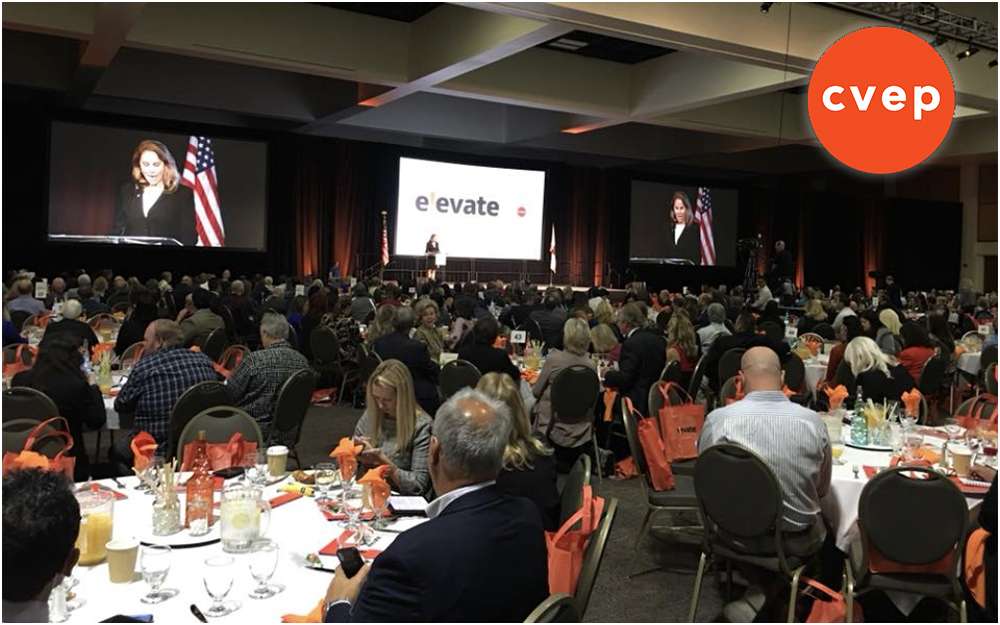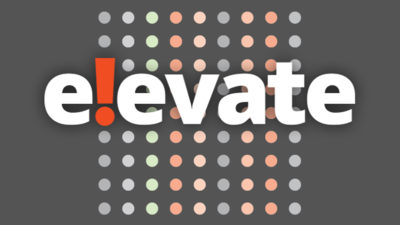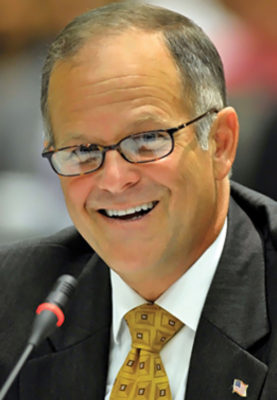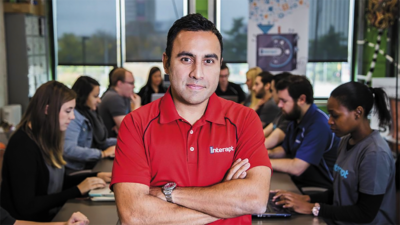
CVEP 14th Annual Greater Palm Springs Economic Summit
By Heidi Simmons
Last week in Palm Springs, the Santa Ana winds blew in from the north and moved through town swaying the tallest palm trees, dislodging dried fronds and scattering them across the manicured city. Along with the winds, came the temperature drop.
It’s November, the triple digits have passed, and the Coachella Valley is beautiful and perfect! This is the beginning of the season – eight months of clear skies and warm sunny days. It is also the beginning of significant change.
The Coachella Valley Economic Partnership (CVEP) held it’s 14th Annual Greater Palm Springs Economic Summit at the Palm Springs Convention Center.
“E!EVATE: Driving Innovation and Enterprise in Greater Palm Springs” was noted as the business event of the year.
CVEP shared plans to bring the future to fruition, addressing the ideas, possibilities, and challenges to generate a sustainable and more prosperous, year-round economy for the Coachella Valley.
IOT – INTERNET OF THINGS
Looking at long-term economic prospects, CVEP recognized that the entire valley must have an infrastructure in place to support a significant increase in digital bandwidth.
“California State University, San Bernardino, Palm Desert campus, and CVEP will be offering data transfer speeds that exceed one gigabit per second,” said Jan Harnik, CVEP Chairperson. “The program will also have the Comcast MachineQ internet of things (IOT) development platform. We believe, that this is the first innovation hub (iHub) in the country to offer both! This digital infrastructure is a strong and positive step that establishes our region as a place to grow and to develop businesses.”
 Admitting she may have sounded like George Jetson, Harnik continued saying, “There is not a business represented in the room that will not benefit from the enhanced digital infrastructure.”
Admitting she may have sounded like George Jetson, Harnik continued saying, “There is not a business represented in the room that will not benefit from the enhanced digital infrastructure.”
The CVEP office is just blocks away from the future College of the Desert’s West Valley campus. Harnik expressed that CVEP expects to see the ultra high bandwidth there, as well as at the other college campuses in the valley.
Harnik thanked Gary Honts CEO of JFK Hospital and Desert Care Network for his leadership, adding: “His vision encouraged CVEP’s evolution to an organization that is leading the region into a future as an emerging technology center with a year round economy.”
“CVEP has a motivated, engaged board and staff,” Harnik said. “We accept the challenge to broaden our economic base and our regions economy. We encouraged everyone in this room to be involved. It is time to elevate.”
The City of Palm Spring has re-committed funding for five more years to CVEP who runs the iHub program and Accelerator Campus.
VISION OF THE FUTURE
Palm Desert architect Kristi Hanson presented a digitally rendered animated video of what the CV could look like in the year 2050.
“We are faced with some crucial and defining decisions,” said Hanson. “If we don’t all act together, the results may be very different. However, since we are in a region with philanthropists, pioneers and entrepreneurs, I am confident that what comes next will bring our region to the best possible outcomes.”
Before showing the video Hanson added, “Today we embrace the changes and welcome the vibrancy they bring to our world. Consider this a call to action to take an active roll in shaping our future.”
In the video, a narrator from the future comes back to 2018 to remind the viewers just how far the CV has come saying: “Don’t let the past keep you from the future you want.”
The narrator complains about the common 2018 problem of regular Netflix crashes. He visits the “World-renowned Cal State University Palm Desert campus,” stating the 2018 community leaders had the vision to invent a cyber security program at the digital iHub.
The state of the art bandwidth and IOT platforms launched the campus onto a growth path that became the integrated learning and innovation centers. It’s programs and leading edge technology sector increased the area’s visibility and attract entrepreneurs and investment dollars.
The narrator explains that the restoration of the Salton Sea began in 2019 saving our valley from ecological disaster. In 2050, it is a vibrant tourist industry that compliments the agricultural business and inland water shed conservation center where cutting-edge research takes place.
The Salton Sea has eclipsed Lake Tahoe as the most visited inland body of water. At the 2050 visitor’s center and cooperative campus of COD, students from all over the world study environmental science, nutritional economics and automated logistics.
Thermal’s Jacqueline Cochran Regional Airport has become an automated interconnected center of trade, a model for integrated logistics and supply change management hub for the entire southwest.
The narrator concludes that the CVEP iHub has transformed standards for innovation, not only in the Coachella Valley, but has centers across the country. He thanks the people in 2018 for what is now possible in 2050.
FARGO & THE COACHELLA VALLEY
Dean Bresciani, Ph.D., President, North Dakota State University, a native Californian originally from Napa Valley, shared how Fargo changed its image and culture transforming itself into one of the nation’s leading cities.
Bresciani compared the Red River Valley and its five cities with a population of 280,000 to the CV’s nine cities of 360,000 residents.
“We have great weather eight months of the year, and you have great weather eight months out of the year. Four months of the year, I’ll admit, are not great at all [in Fargo], but come here in the summer and some would say your weather isn’t great either,” Bresciani said. “The big difference between the two valleys is: the economy in the Red River Valley is increasing exponentially as is the population. Here, it is a hold-even state not realizing its potential.”
 Bresciani explained the two factors that worked in combination to change Fargo in only 20 years. Number one was higher education. Building universities and colleges not only created jobs and generated significant economic impact, but the scholarly growth and reputation established national visibility that it never had before.
Bresciani explained the two factors that worked in combination to change Fargo in only 20 years. Number one was higher education. Building universities and colleges not only created jobs and generated significant economic impact, but the scholarly growth and reputation established national visibility that it never had before.
For Fargo, one university was the economic catalyst that made a billion dollar impact!
“What makes people want to live and start a business in Fargo is connectivity,” said Bresciani. “The connectivity factor is critical in drawing business and young people. We have two firms now providing one gig capacity in the area. I’m excited for what’s coming here, but also recognize you are already two years behind Fargo!”
The results of these two factors is measureable. In North Dakota, every public dollar spent on education was a $7 return to the state in economic impact emphasizing Bresciani’s mantra: “Educated citizens give more and need less in society.”
“If it’s possible in North Dakota, imagine where else it’s possible,” said Bresciani. “Nothing had changed from 1940 to 1980 in the downtown business area of Fargo. It was the colleges and universities that made that possible. Young people are critically important to our future.”
Bresciani concluded by saying: “The opportunity is in front of you if you take advantage of the young, higher education, and connectivity. Expand beyond one gigabyte. Don’t be the last, be the first.”
ELEVATING THE COACHELLA VALLEY
“Elevate is doing something everyday that makes your life, business and community better,” said Joe Wallace, CEO, CVEP. “We have the E factor — educating, engineering and entrepreneurship.”
Wallace shared statistical data about businesses and earning potential. He encouraged creating careers that not only provide a living wage but a thriving wage.
“The businesses that have generated the most jobs and greatest income are less than five years old. That means growth depends on start ups and emerging business,” said Wallace.
Wallance interviewed Joel Kinnamon, Ed.D, College of the Desert President, on video about meeting the educational demands of the future.
Kinnamon remarked that with the help and support of the community, COD is prepared to assist students to be successful and earn degrees.
“Without duplication, every valley COD campus will have high-end, state-of-the-art programs,” said Kinnamon.
“It’s amazing what just a little bit of imagination and generosity can do,” said Wallace, to which Kinnamon strongly agreed.
Wallace pointed out the top 25 highest paying jobs in the country were all are STEM related — Science Technology Engineering Mathematics — with salaries of $100,000 and better. The list of jobs, all required a bachelors degree or higher.
In a video interview with Gemma Kim, MD, UCR, Palm Desert, Wallace discussed the need for health care providers in the CV. The program trains new doctors at Desert Regional Medical Center.
“There are pockets in our valley that have one doctor for 9,000 patients,” said Kim. “The normal ratio should be one physician for every 2,000 patients.”
Kim was happy to report that six of the seven residents in the first UCRPD graduating class, chose to stay in the CV. The reasons they are able to keep doctors locally include affordable housing, ongoing training programs, and local resources.
The UCR Health Family Medicine Center in Palm Springs is run by the program’s residents and faculty. The facility has 20 exam and two procedure rooms. It serves 30,000 patients a year.
Wallace shared more details on the region’s move towards meeting the needs of the future.
NECESSARY BANDWIDTH
“Digital iHub Entrepreneurship Program is a game changer,” said Wallace. “It is one of the programs on the horizon along with many others.”
With more advanced programs and businesses, and the infrastructure in place, Wallace sees an increase of connectivity to 100 gigabytes per second!
Wallace also talked about the importance of adults reinventing themselves. “The world is changing fast,” he said. “Our schools are re-training people who need a new skill… 50 percent of jobs are in the bull’s eye for automation. We need to reinvent our workplace so people don’t end up without a marketable talent or skill. Portable skill sets and the ability to think are important.”
According to Wallace, Cannabis, “the great green hope,” will continue to make a lot of money for business owners, but as it moves towards automation, it will eliminate more jobs than it will create.
Wallace discussed the demand for cyber security entrepreneurs with Dr. Tony Coulson, Director CSUSB Cyber Security Center.
Coulson and his department are seeking valley residents who have an aptitude and entrepreneurial spirit to build the program.
“It’s important to raise up the community to meet this national demand,” said Coulson. “Cyber security is a new job environment where the sky is the limit.”
The starting salaries in the field can be in the six figures.
LOCATION, LOCATION, LOCATION
Wallace used Huntsville, Alabama’s technology based business success to illustrate what can be done in the Coachella Valley.
Wallace ticked off the CV’s advantages: “We have CENIC Bandwidth speeds, IOT development platforms, close proximity to a base of over twenty million people. We have Southern California, an education system and worldwide recognition! We are going to take advantage of that!”
PEOPLE POWER
Guest speaker Ankur Gopal, CEO Interapt, spoke candidly to the audience about the difficulty in finding and retaining talent to work in his IT services firm, a company that specializes in “innovation-as-a-service” software.
Starting in his parent’s Kentucky home after college, Gopal’s business took off. But, he quickly realized he lacked the people – the talent – to take on more business passing up millions of dollars. It was a problem he was compelled to solve!
“We learned you have to build a workforce that can continuously learn,” said Gopal.
Gopal approached the local community college and set up a curriculum and mentoring program. With that success, the Governor asked Gopal if he could teach former coal workers to code.
“We have to re-train people if we are going to compete in the world,” said Gopal. “We figured out how to teach non-traditional students.”
Gopal has taken his program to the military and is re-training veterans and their spouses.
“We have an opportunity to lift up the community by training those who want to work,” said Gopal. “What can we do to give people upper mobility for the rest of their life? We teach the skill of how to learn.”
Gopal has seen first hand the return on investment (ROI) from re-training and teaching locally.
“I think if you are a company that wants to compete in the next generation economy, you have to come across with some diversity of thought and think broadly,” said Gopal. “Think of your citizens as infrastructure. Investing in your citizens is a multiplier in the economy. For each person with a good job, it creates five ancillary jobs. To create a thriving community, you need all people, all walks of life to succeed.”
LOCAL ECONOMY
 Economist Manfred W. Keil, Ph. D., Claremont McKenna College was the final speaker of the CVEP Elevate Summit. Filled with wit, wisdom and charm, he addressed the rumors of a “2020-21 Recession” and the important economic indicators.
Economist Manfred W. Keil, Ph. D., Claremont McKenna College was the final speaker of the CVEP Elevate Summit. Filled with wit, wisdom and charm, he addressed the rumors of a “2020-21 Recession” and the important economic indicators.
“Long run visions are really important,” encouraged Keil. “You need to know where you are going. But, the short run is also important when it comes to forecast. Especially out here in the inland empire. It was a very slow recovery. Now, Riverside and San Bernardino have seen the highest employment rate.”
Keil talked about what was relevant to the Coachella Valley but also looked nationally for recession indicators. During the 2007- 08 recession, every eighth person lost a job here in the CV.
Using graphs and charts, Keil looked at the CV’s nine cities’ housing, population, industry, jobs, commute times, growth rate, age factors and other local data.
“We have had nine years of economic expansion,” said Keil. “It is remarkable how the economy grows. You look for a common theme. Growth of GDP –gross domestic product– is at plus or minus three percent and that is all you need to know.”
Keil mentioned consumerism and that if it continues to go up, that indicates forward thinking. Variables include consumer sentiment and confidence. Consumption is 70 percent in the US.
So far, Keil doesn’t see a downturn in economic conditions, which would indicate a recession. He noted that home construction is still low and has yet to recover, but could not say why or what that might indicate other than the high cost of lumber due to Trump tariffs.
Like the other speakers, Keil identified the human factor saying if you have a community with low education, it will have high unemployment.
“The inland empire is a leading indicator in recession — first in, last out” said Keil looking at his graphs. “Things turn bad here, before the state and nation. There is no evidence of something bad coming up. There is nothing for you to worry about at this time.”
TECH REALITY
 The message of the summit was clear: Technology based industry is the future, and to compete and succeed, the region needs an educated workforce.
The message of the summit was clear: Technology based industry is the future, and to compete and succeed, the region needs an educated workforce.
The nine cities and their representatives, along with educators, entrepreneurs, and local businesses, took in the reality of the inevitable, contemplating the next steps to sustain and elevate the community.











































